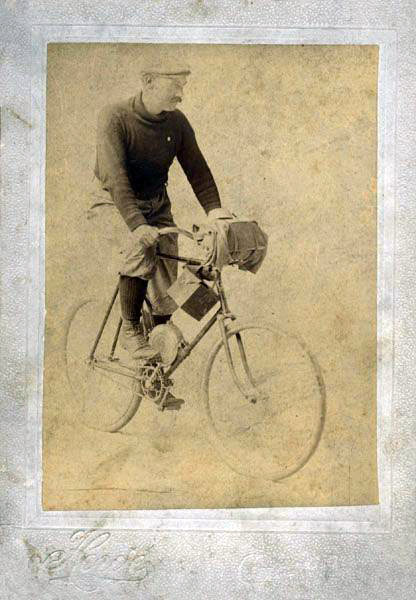From Seattle, Washington to Marysville, Ohio on a Fowler Truss frame wheel in 53 days, covering over 2,600 miles on eighty-five dollars and fifty-nine cents. That is how William Henry Sheneman spent the summer of 1896.
On the day he left Seattle, a newspaper article of June 18, 1896 comments that it is becoming the fashion to "visit the old folks at home by taking the wheel route rather than a train when an expert wheelman wants to go back East." It referred to my great-uncle, Will Sheneman, who had been living in Seattle for ten years, and was the nomad of the family. The article notes he is a 200 pounder who expects to be considerably thinner by the time he reaches Union County, Ohio where he was born, and where his folks live.
Along with 25 pounds of luggage, consisting of a roll of blankets, a couple changes of clothing, a canteen and a Kodak camera, he carried a notebook that has been handed down to me through three generations. It is filled with his day-by-day description of his trip including mileage covered, and an accounting of expenses. Leafing through its yellowed pages brings up vivid pictures of his adventures, trials and triumphs. Since roads were few, and not numbered in those days, he lost the way many times, and had to retrace his route. He often walked the railroad tracks carrying his wheel where there were no roads. At the two mile long Stampede Tunnel on the Oregon Shortline Railroad he walked through with permission from the telegrapher. He writes: "Knowing it was two hours before the next train was due to pass under the mountain I entered the tunnel and groped in the darkness, but could not walk straight, running against first one rail and then the other. So difficult was it to walk that I could make no progress, and would be caught by the next train if I did not go faster. Finally I tried walking on the rail and using my wheel for a cane. In this way I made fairly good time and in fifty minutes I had passed through and was again in daylight."
He followed the old stage-coach road in Oregon for several hundred miles. Since the railroads came through it had degenerated into no more than a trail, but evidence remained of channels cut by carriage wheels where the ground was cut up for ten or twelve rods wide.
Travel was difficult through the sandy deserts and over the mountain passes. On June 24th while in eastern Oregon, Will noted the temperature was 100 degrees in the shade, and there was no shade. He writes: "About 1:00 PM I came to sand and had to abandon riding although the sand was so hot it almost burned my feet, and I would sink to my ankles every step. I could not lead my wheel but had to get behind and push. Finally after my shoes were full of sand I took them off and walked in my stockings."


 English
English  Italiano
Italiano  Français
Français  Deutsch
Deutsch 